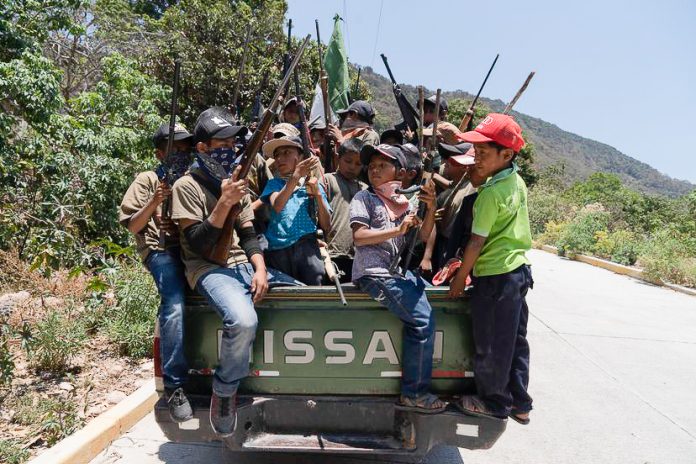A group of armed children in Guerrero has appealed for government help to combat high levels of violence in the state’s lower mountain region.
For a third consecutive year, boys wearing caps, kerchiefs, and huaraches (traditional sandals) and toting firearms and sticks participated in a military-style parade on Saturday in Ayahualtempa, a town in José Joaquín de Herrera.
The parade, in which adult community police members also participated, serves as both a call for help to the federal government and a show of force to criminal groups, such as Los Ardillos, that operate in the opium poppy-growing lower-mountain region, located east of the state capital, Chilpancingo.
Video footage published by the newspaper El País shows a group of armed boys firing weapons after an adolescent member of the community police-in-waiting denounces the government for not providing security.
The armed youngsters demanded that the government provide support to widows, orphans and displaced people and made it clear that they are fed up with crime and discrimination against indigenous people.
The founder of a local self-defense force told El País that there were six clashes with narcos last year and lives were lost on both sides. Bernardino Sánchez Luna denounced the inaction of the authorities and said the community police are forced to train children in the handling and use of weapons so that they too can protect themselves if they come under attack.
He noted that President López Obrador has said that he is on the side of the people and promised that his government would prioritize assistance to the nation’s indigenous citizens. The reality, Sánchez said, is very different.
“We’re indigenous here, and we haven’t received any support from the federal government,” he said. “… It only makes promises … but doesn’t keep any of them.”
A 27-year-old woman told El País that she wouldn’t like her children to wield weapons but acknowledged that she might not have a say in the matter.
“It will be what God wants. I wouldn’t like my children [to take up arms], but if that’s what the town decides, nothing can be done,” Claudia Bolaños said.
Her eldest child is a 5-year-old boy, just one year shy of the age of the youngest of the community police-in-waiting.
Romain Le Cour, the cofounder of Noria Research, a collective of researchers and analysts that studies international affairs and conflict, supported Sanchez’s claim that the town of Ayahualtempa and other communities in the region have been abandoned by authorities.
“In the face of a simplified discourse that attributes all [problems] to the narcos, the authorities end up looking the other way. ‘There’s nothing to do,’ they seem to say,” he said.
“What’s happening here is much more complex,” Le Cour said. “It’s a social problem, a problem of poverty and neglect. It’s not enough to blame the violence on narcos and leave indigenous communities to govern themselves without help.”
The hartazgo [the feeling of being fed up] of the residents of Ayahualtempa, the municipality of José Joaquín de Herrera — where at least nine women have been widowed by violence and 14 children have been orphaned — and other towns in the region is forcefully encapsulated in the words of the teenage boy who orders his fellow “child soldiers” to shoot in the air during their show of force.
“If there isn’t anyone who defends us, we’re going to respond to the [criminal] hitmen with [our own] fire, motherf*****s!”
Source: El País (sp)
